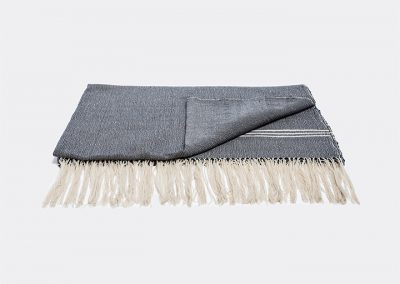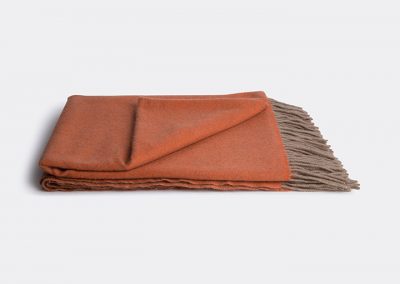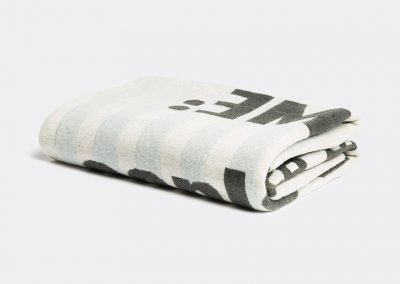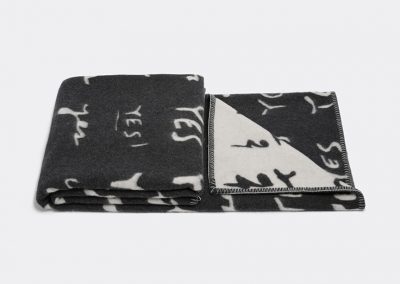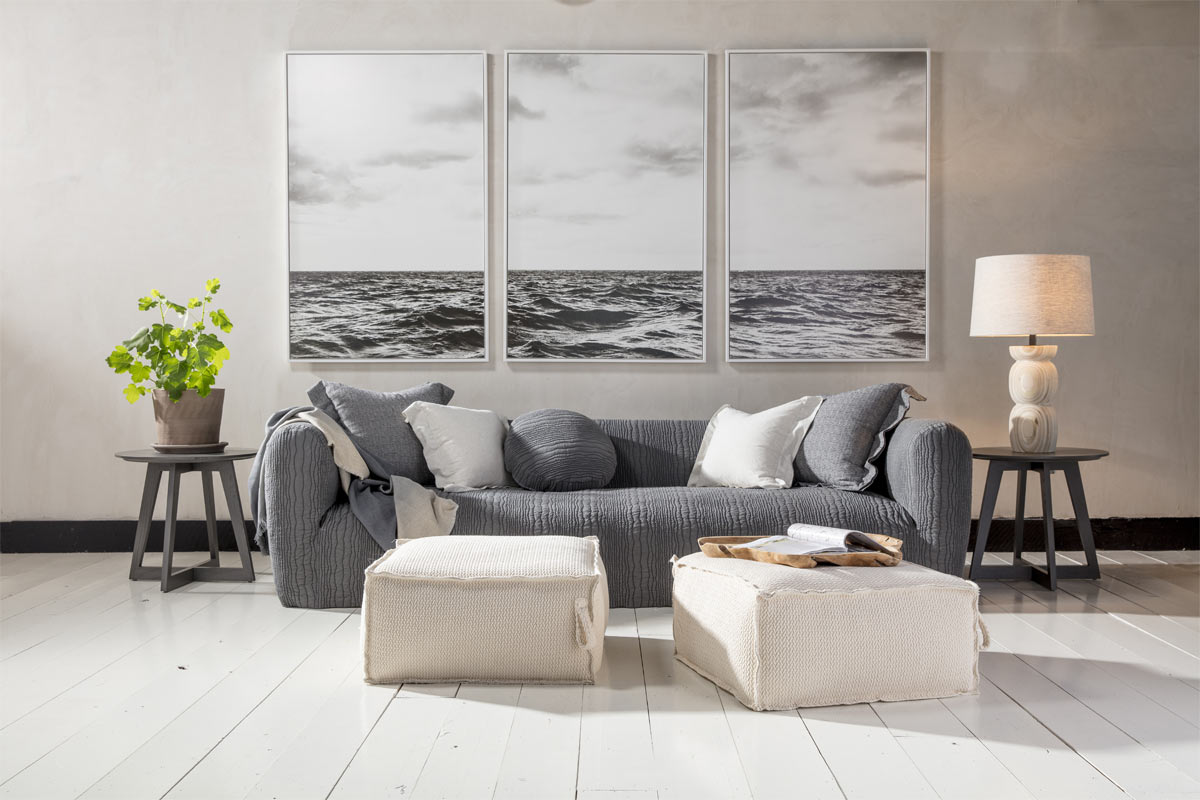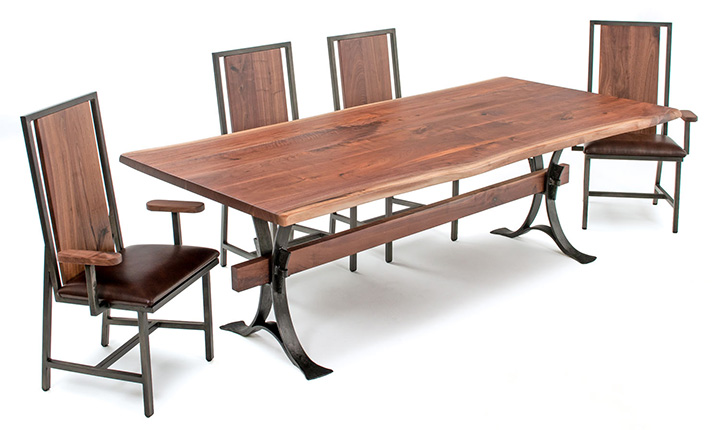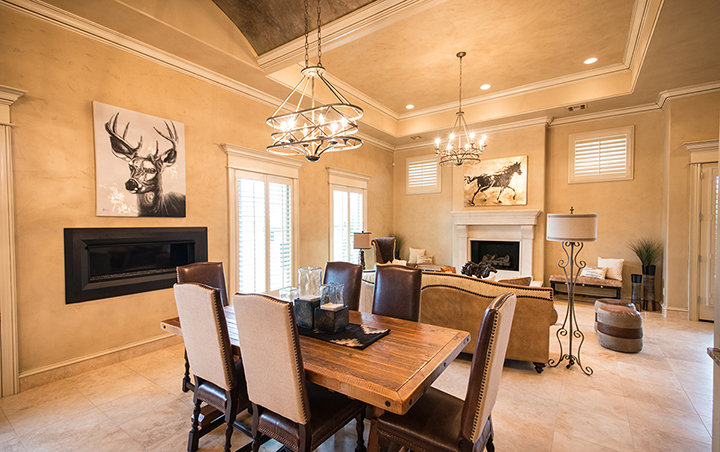Making an iconic design statement in a minimal aesthetic, the Dawn to Dusk lighting fixture is the newest product released by the award-winning London-based design studio haberdashery that invites you to experience the magic of sunrises and sunsets from right inside your home.
The intricate design was inspired by the “the memory of the sun” and creating a strong connection with this memory, according to Ben Rigby, creative director and co-founder of haberdashery.
“We want to reach beyond the industry’s current expectations for a lighting product and push for a more ambitious blend of quality, creativity and narrative-driven design all wrapped up in an iconic, useful and aesthetically beautiful design statement,” says Rigby.
To do this, Rigby and other designers chose to work with an uncomplicated design to demonstrate the clarity of a rising sun, as well as identified the perfect color range that would create a strong, emotional resonance.
Available as a table and floor-standing lamp, the diffused circular light source explores a palette of warm colour hues during its transit of the vertical stand, delivering these as direct light, or as a flood of light on a wall.
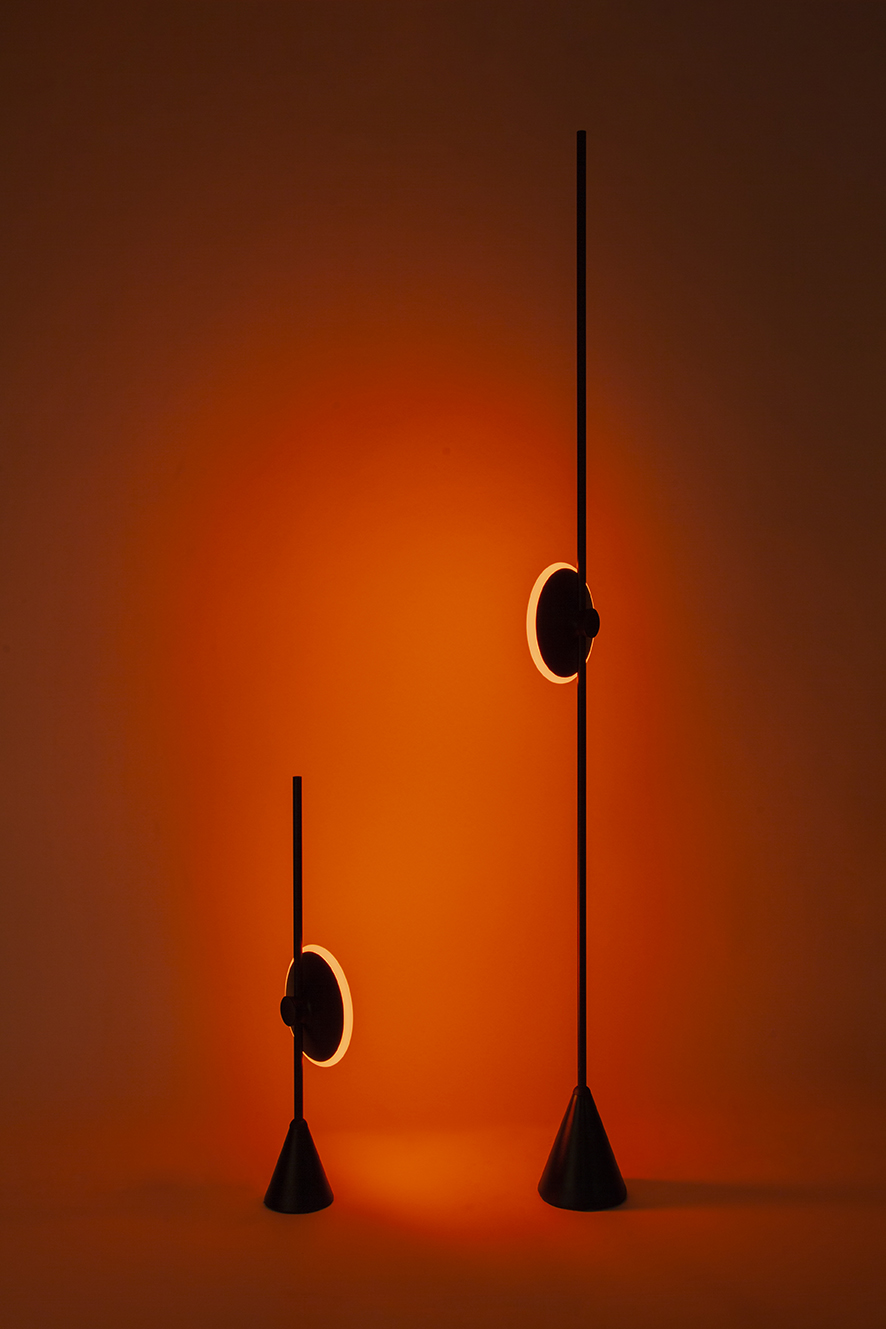
When at the base the sliding light head sits in an off position, and then as it is moved upwards it activates a low intensity red hue, which transitions into orange, then 2700k white light as slid upwards. This custom LED light array, developed by Rigby and his team, replicates the transition of light from the deep, rich red of the late evening to the white light of midday. The light is also capable of rotating 360 degrees around, providing a range of uses from outward facing task light through to a backward-facing ambient light, creating a subtle wash.
Dawn to Dusk is meant to not only showcase a naturally beautiful occurrence but to also utilize this power to support our natural rhythm throughout the day. The high-quality white light helps users to wake up more naturally, while the richer, relaxing red colors help regulate the circadian cycle and prepare for sleep.
“haberdashery believes light is a transformative power in the world; we challenge what is possible with light, and through our products are defining a new category of contemporary lighting,” says Rigby.
All photos & video courtesy haberdashery.
Celebrating its 40th anniversary, Artefacto is committed to designing with function and style in mind, while blending global influences from Italy, France, Brazil and beyond. The new collection arrives this month to the U.S. and embodies Artefacto’s signature contemporary aesthetic, now with a tribute to cinema and technology.
The pieces are all inspired by classic movies, with textures and finishes like exotic marble, stainless steel and sophisticated fabric. Every piece in this new collection features a star-studded name straight from the silver screen, like the Harrison Chaise Lounge, Carrie Lounge Chair, Indiana Lounge and Lauren Chair.
Paulo Bacchi, CEO of Artefacto, feels the new collection perfectly blended the old with the new. “Artefacto borrowed the styles of classic old Hollywood to create a timeless new collection that is simple yet elegant,” he said, “Completely customizable, these pieces have a refined versatility that will add a touch of character to any space.”
As for the Hollywood influenced pieces, Bacchi said, “Hollywood represents an eclectic industry that is all about glamour, sophistication and lasting style. Rich textures, satiny finishes, polished metals and deep colors are central to our new collection.”
Deep, rich tones like navy, dark brown and black inspired this collection, according to Bacchi. evoking luxury and dramatic glamour. His favorite pieces include the Float Shelf and Carrie Swivel Lounge Chair. “Their smooth shape, polished finish and subtle, metal details make them timeless, sophisticated pieces,” said Bacchi.
Constantin Buffet/Bedside Table
Made of a stainless-steel base, with wood and suede interior. The main frame of this piece comes in a variety of high-gloss or matte colors, including white, sand, noir and black. The suede interior is available in sand or paprika, depending on customer preference.
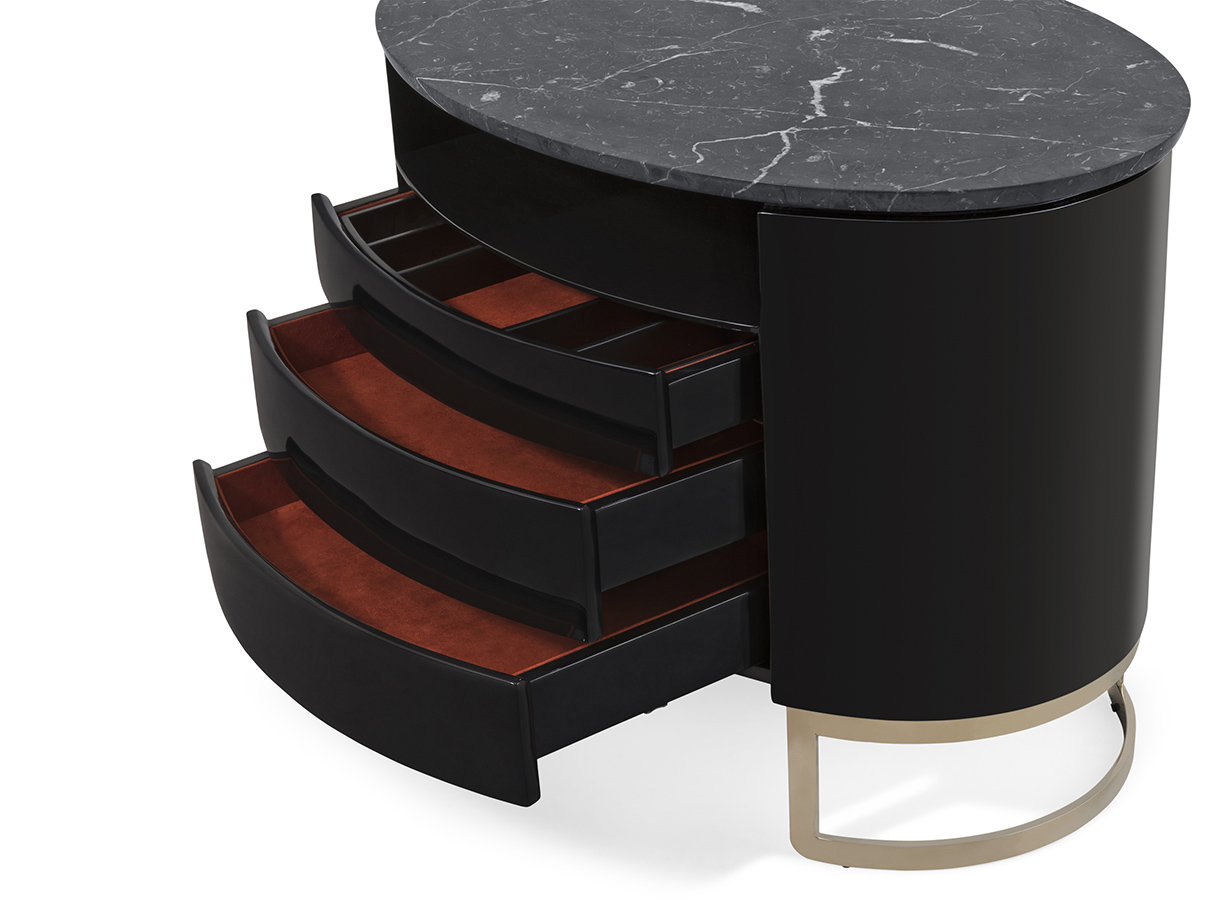

Carrie Swivel Lounge Chair
This gorgeous swivel chair is made of a stainless steel base and upholstered fabric with leather option. The swivel base of the chair is also equipped with a return system.
Float Shelf
Completely customizable, the Float Shelf is made of wood frame and steel base, and along with the legs, are available in a variety of colors.
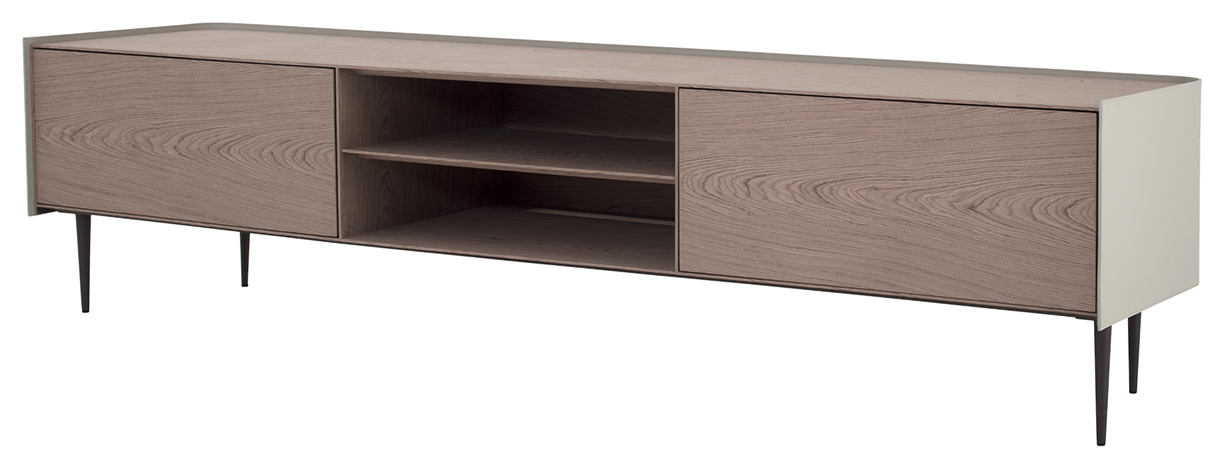
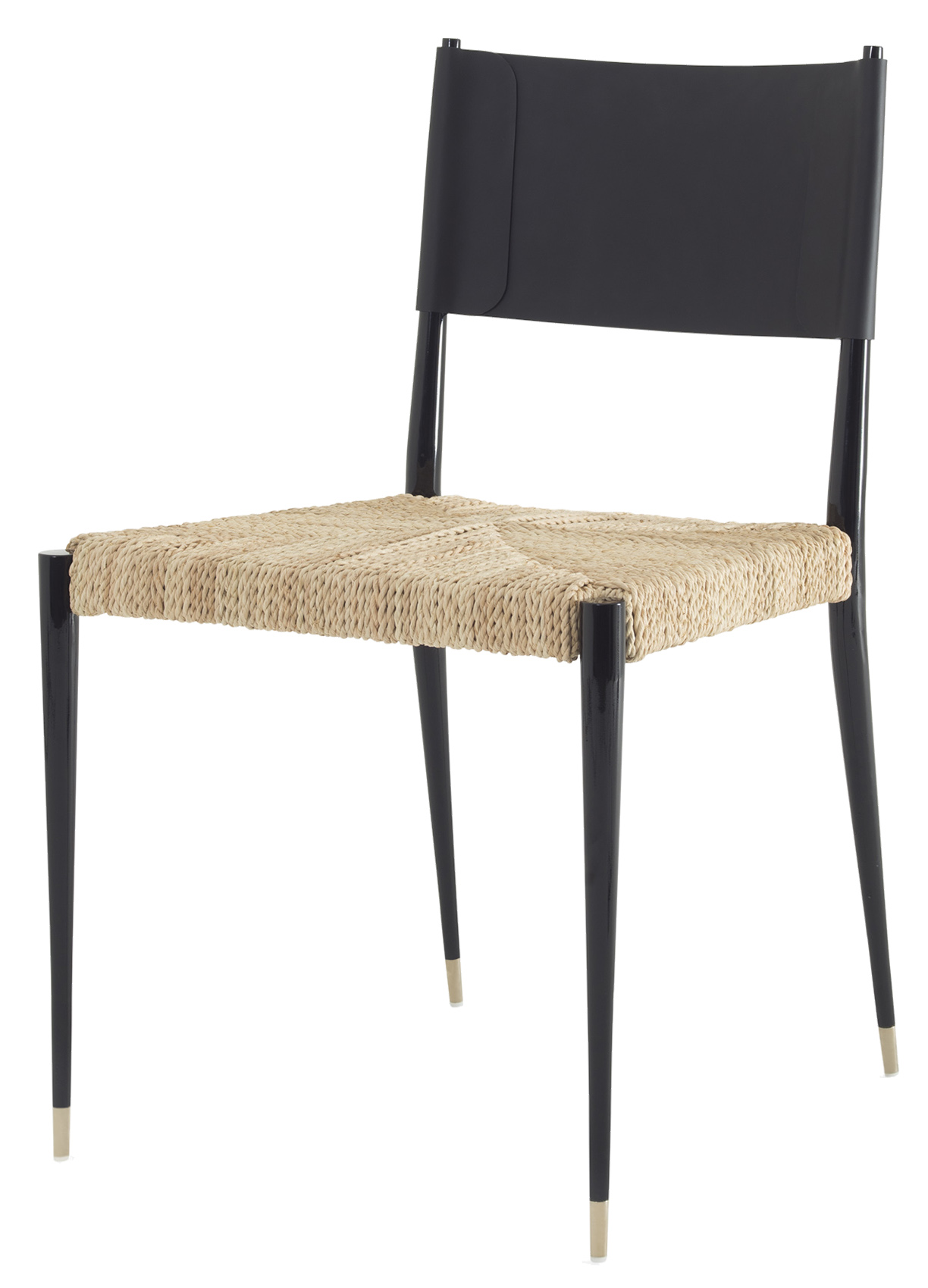
Hara Chair
This stunning chair is made of natural, woven Brazilian Burati palm fiber with stainless steel base. Legs and backrest are available in a variety of colors.
Indiana Collection
The Indiana Collection is made of stainless steel, natural fibers, woven using a Malacca weaving technique. The legs are available in a complimentary finish of polished silver, gold or rose. The cushions come in a variety of colors and materials, based on customer preference.
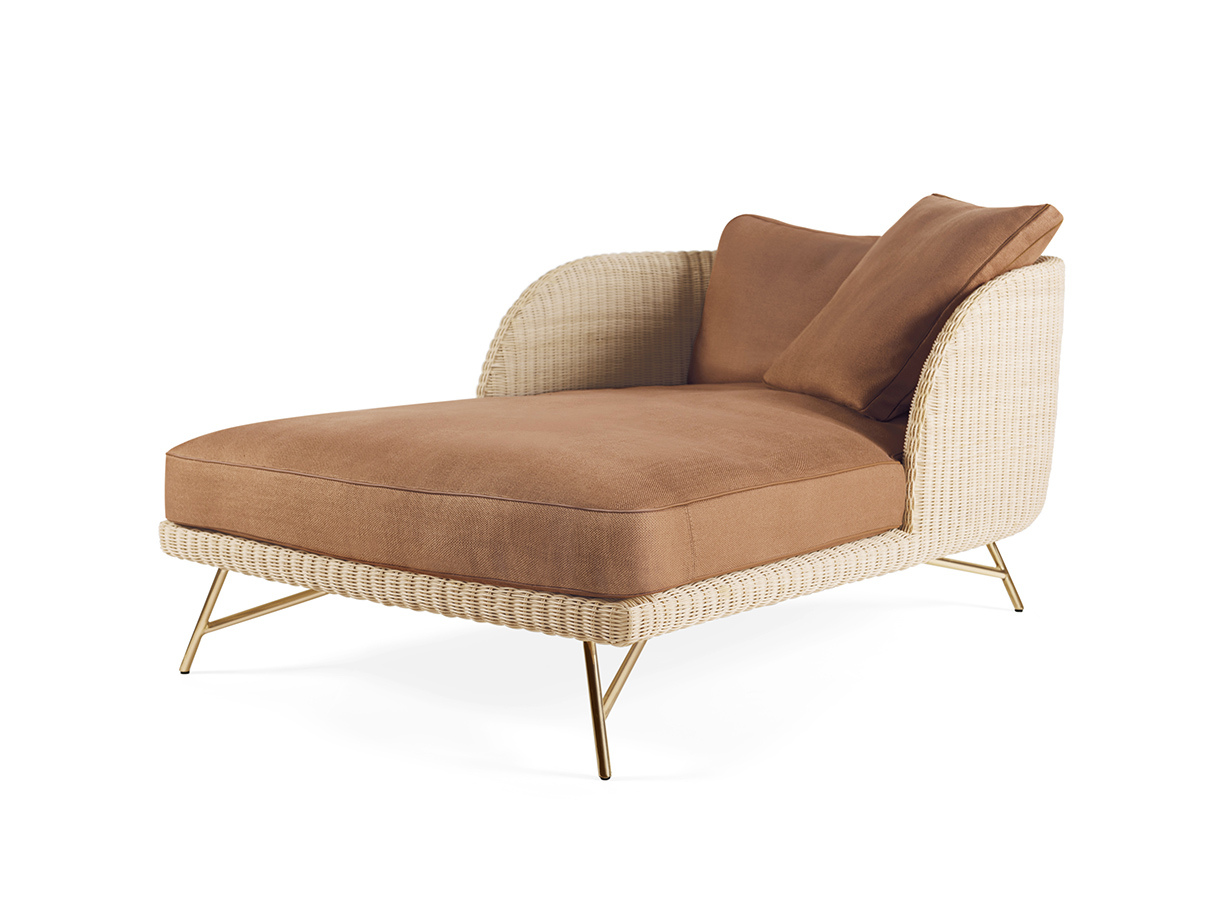

Over a decade in the furniture business led me to a simple conclusion: The furniture industry needed to be reinvented. It was dominated by legacy players who were doing the same things for generations, while the hospitality industry was changing dramatically. Hotels and other public spaces were turning into immersive experiences where design and style statements mattered more than ever. But when it came to furniture, the big players were unable to deliver the quality, speed, and responsiveness that this new world demanded within hospitality players’ budgets.
So, I created White Space to fill this void.
At the heart of our model is a new infrastructure that delivers a custom-built supply chain for every project. We work with — and manage — the factory best suited for the task, no matter where in the world it’s located. This is the big change the industry needed — the ability to manufacture the highest quality furniture, casework, lighting fixtures and flooring with scale, efficiency, and attention to detail.
To put it another way, my inspiration for starting White Space was identifying that there was a white space in my industry — a gap that we could successfully fill.
What is the big change you’re bringing to office spaces?
We’re eliminating the false choice that existed in the market: that you have to choose between quality and affordability, or creativity and efficiency. Buyers and purchasers of all kinds were resigned to picking out generic furniture from a catalogue, because that’s the way it had always been. Now no one has to make that choice.

It really started with the epiphany described above, and the realization that I had the experience to start a company like this. I knew the strengths and weaknesses of so many factories around the world — and I had cultivated the professional connections and knew the projects I brought them would get the focus and effort they deserved.
Those connections also mean that we can bring our own quality-control teams on site: they’re there at every stage of the production process to make sure we’re delivering exactly on our clients’ specs. Because of our ability to deliver the highest quality on time, within budget and at scale, we’ve been able to mature very quickly and work with some of the biggest names in the hospitality industry — from Disney to the Ritz-Carlton.
What are some of your favorite projects?
One of my favorite projects is the work we did for the Nakoma Lodge. I feel particularly proud of this — not only because it came out so well, but because it is an honor to be associated with a Frank Lloyd Wright design. That we were able to successfully and seamlessly extend his aesthetic speaks to the power of the system we’ve built, to fully realize even the most complicated and nuanced of visions.
Also, I feel very proud of the work we did with WeWork to open their Tel Aviv flagship. They are clearly changing the workplace and it’s a thrill to be part of that change. They also have high standards and a sophisticated vision for their brand, that’s always extended to the spaces they design, so it was extremely gratifying that they chose us. It’s also always fun to work on such a cool, trend-setting project.
How is White Space innovating office spaces today?
We’re helping to kill the cubicle — and more broadly, the fluorescent-lit, colorless, isolated environments that employees were almost universally forced to work in a few years ago. A lot of modern corporate offices are taking cues from the hospitality industry, surprisingly enough: the shared spaces that encourage socialization and collaboration are increasingly a focal point in corporate office design, as we come to realize that happy, healthy employees who actually like each other end up more productive. People do more when work when it doesn’t feel like work — and creating that vibe and work ethic starts with the physical environment. It’s the main reason people come to us to make their offices feel less like offices.
What are your future aspirations for White Space?
I aspire to continue to expand globally, both within the hospitality industry and within adjacent industries, including co-working spaces. We want to continue to work with creative brands who have expansive visions, and with designers that share these qualities. We’re here to support anyone who has an envelope they want to push.
The system we’ve created is agnostic to the project, and we want to work with people who’ve been boxed in by their previous vendors, that couldn’t deliver as fast and as fully as we can. We help those companies compete through innovative design. Design is a true competitive advantage today.
Photos courtesy of White Space
Meant to add that perfect finishing touch, accent pieces carry an important weight when it comes to completing a room’s design, from the size of a mirror or its frame to the brightness of matching lamps. High-end brand Frontgate understands the impact these items have on a space and offers an assortment of essential furnishings that bring that space together.
Mirrors
Finding the perfect accent mirror means finding the balance between functionality and beauty. If function is the priority, Frontgate offers pieces that keep this balance in mind. From the tropical Marigot Shell Mirror or the Temple Chinoiserie Wall Mirror, both optimal for spaces like bath vanities or entryways, beauty no longer has to be sacrificed.
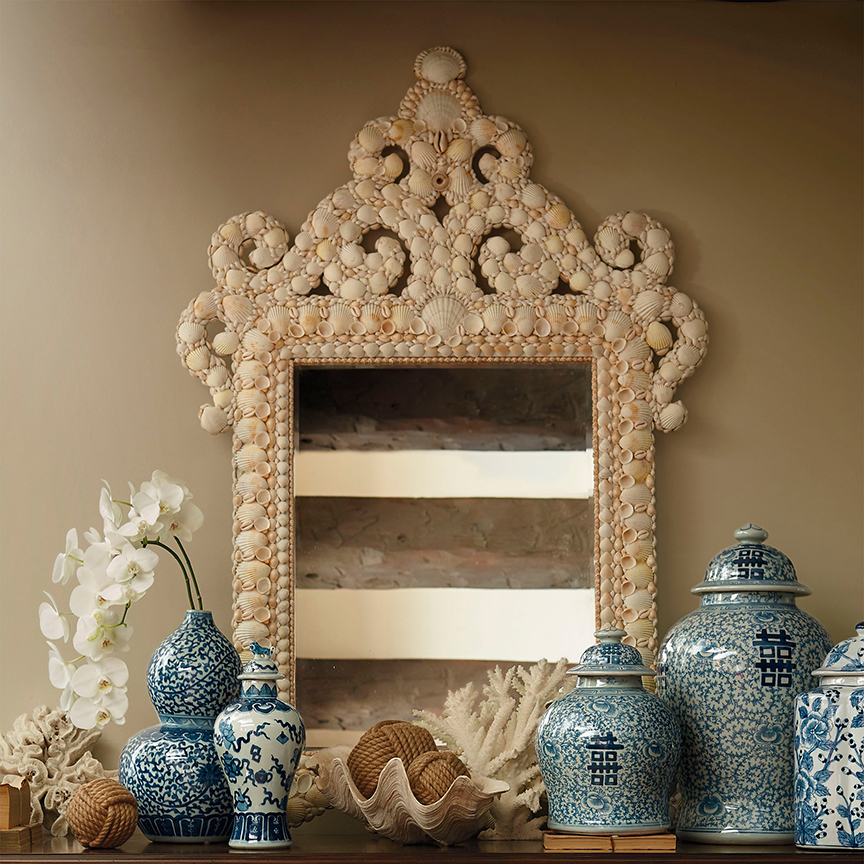
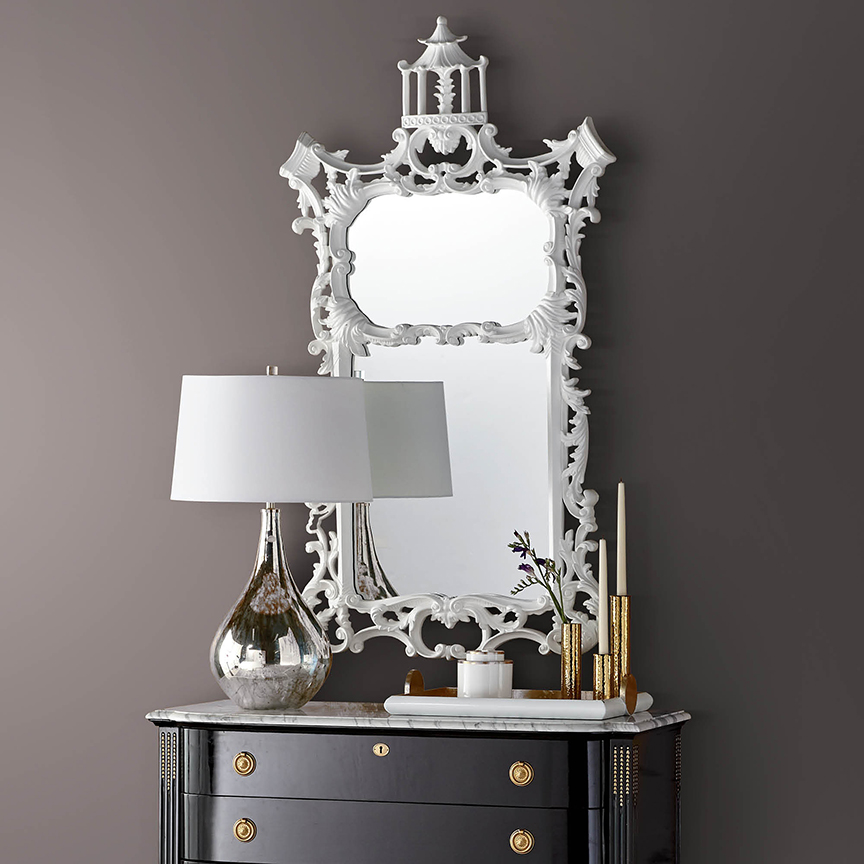
For Frontgate it’s all about making a statement, according to a brand representative, while also working with the space given. A perfect example is the Duchamps floor mirror. From the dressing room to the living room, this large floor-to-ceiling mirror with additional storage opens up a space with its reflective surface and creates a visual impact. For even more creative displays, art-inspired pieces like the Intermix Beveled Mirror also open a room and add a bit more interest to a simple space.
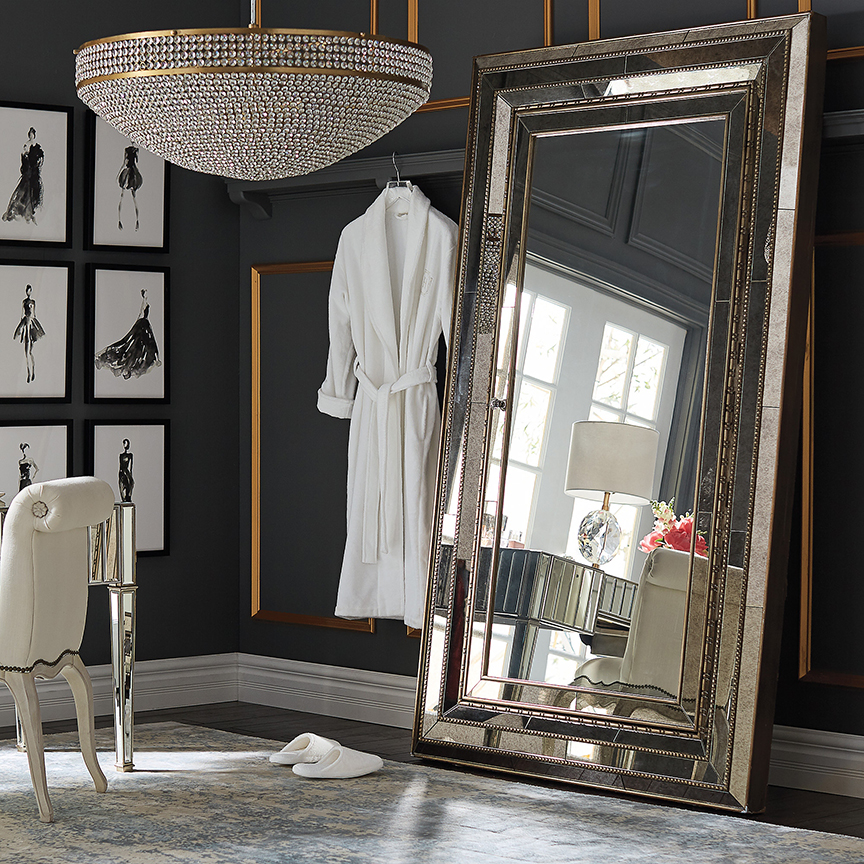
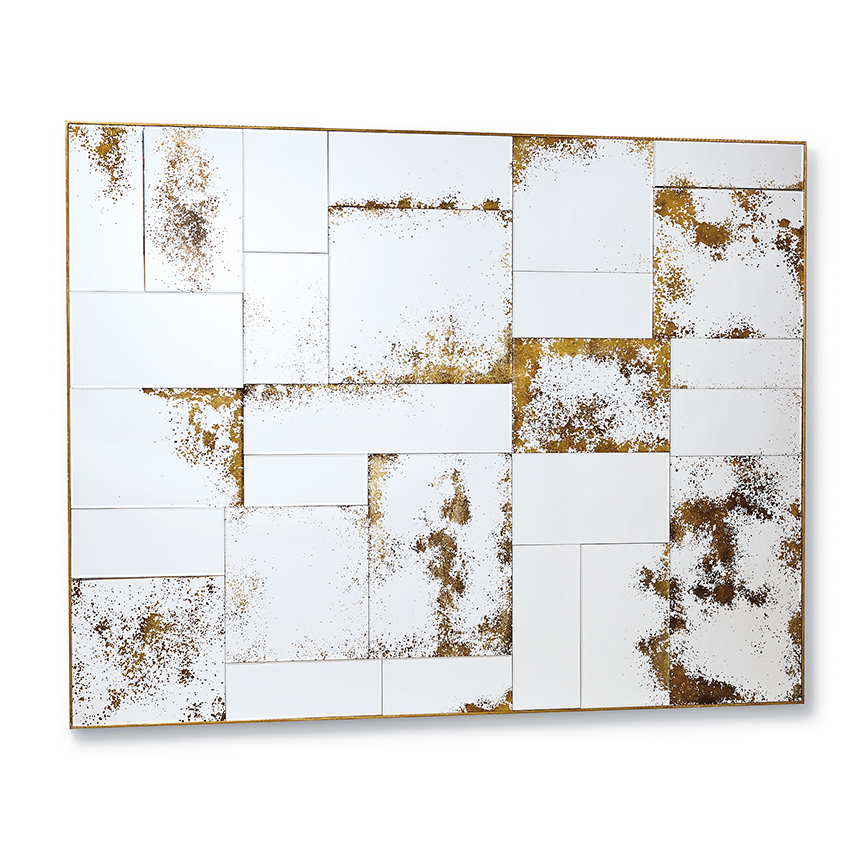
Geometric Pendant Lighting
Symmetry is key when it comes to lighting, particularly with pendant lighting options that usually come in twos. Geometric pendants are popular for a number of reasons. The variety of finishes and materials used to create them fit easily into almost any space. From the simple and elegant Maxwell and Tillary lights with metallic gold and brass finishes to the glamorous Aurora pendant, these fixtures have the ability to create a dramatic focal point in rooms that are purposeful on their own.

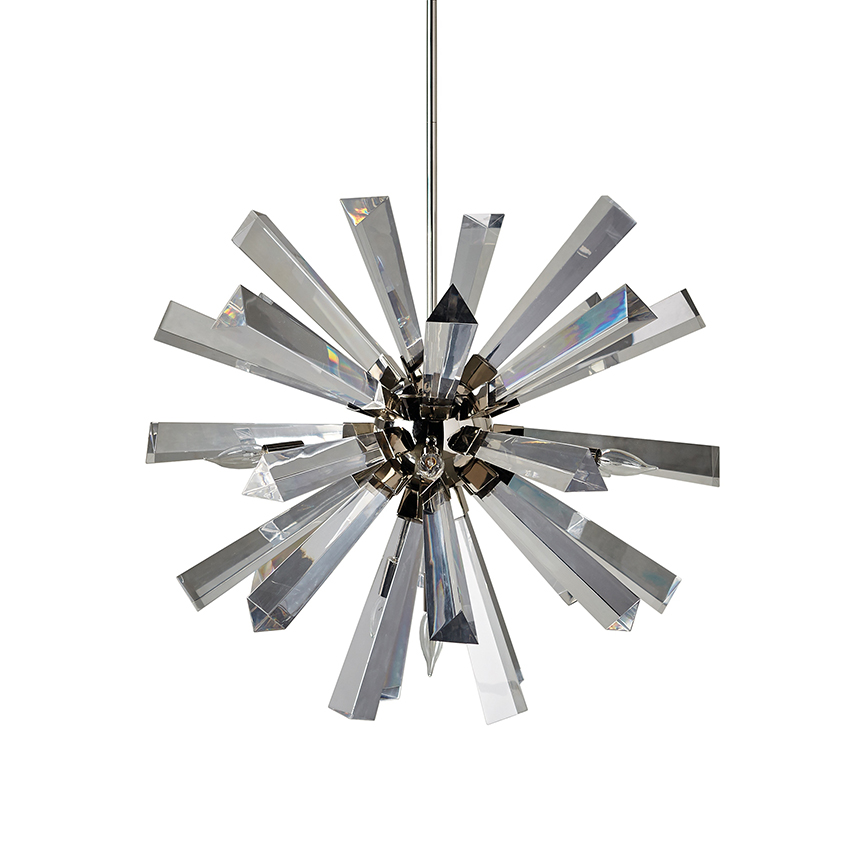
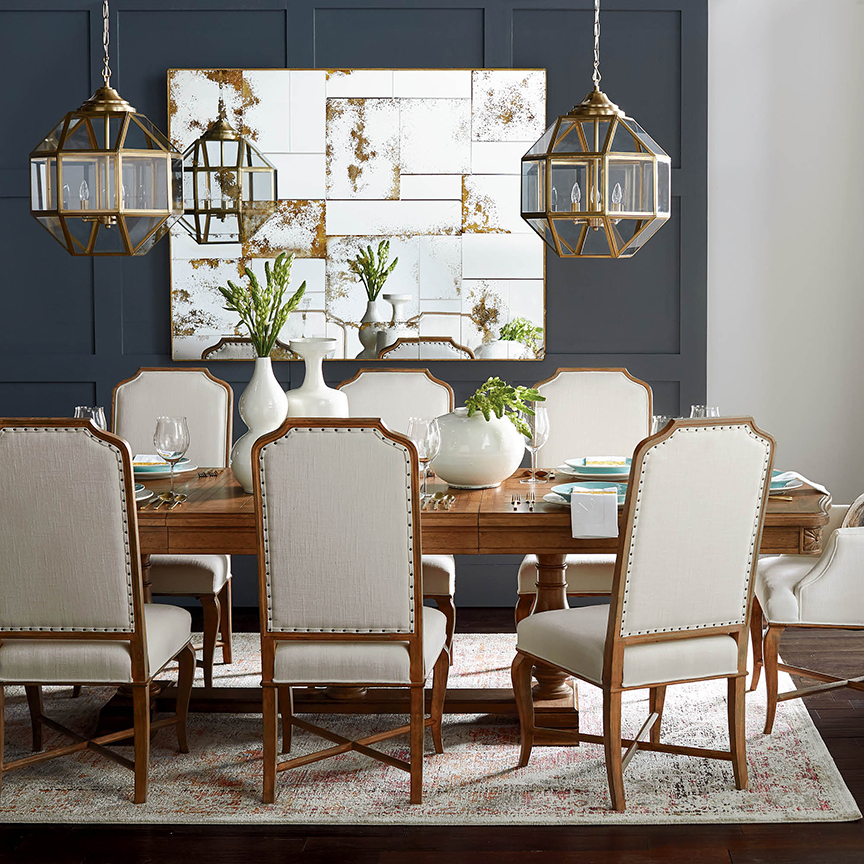
Velvet Pillows
An ever-widening trend in fashion and home design has been the inclusion of velvet in more ways than one. Particularly with pillows, Frontgate representatives says that “whether made of cotton or silk, crushed or devoré, running your hand along a length of velvet is a sumptuous experience.”
The transformative powers of the fabric are never-ending; a cold house becomes a warm home when a velvet throw is draped over curves, catching the light and bringing a dimensional texture to a piece of furniture or to a room. And while velvet is known for playing well with other fabrics in fashion, it also pairs perfectly with faux fur, brass, glass, marble and more. Scattering some velvet pillows on a neutral-colored couch adds a visual, tactile warmth, perfect for the fall, transforming a simple space to a sophisticated room.
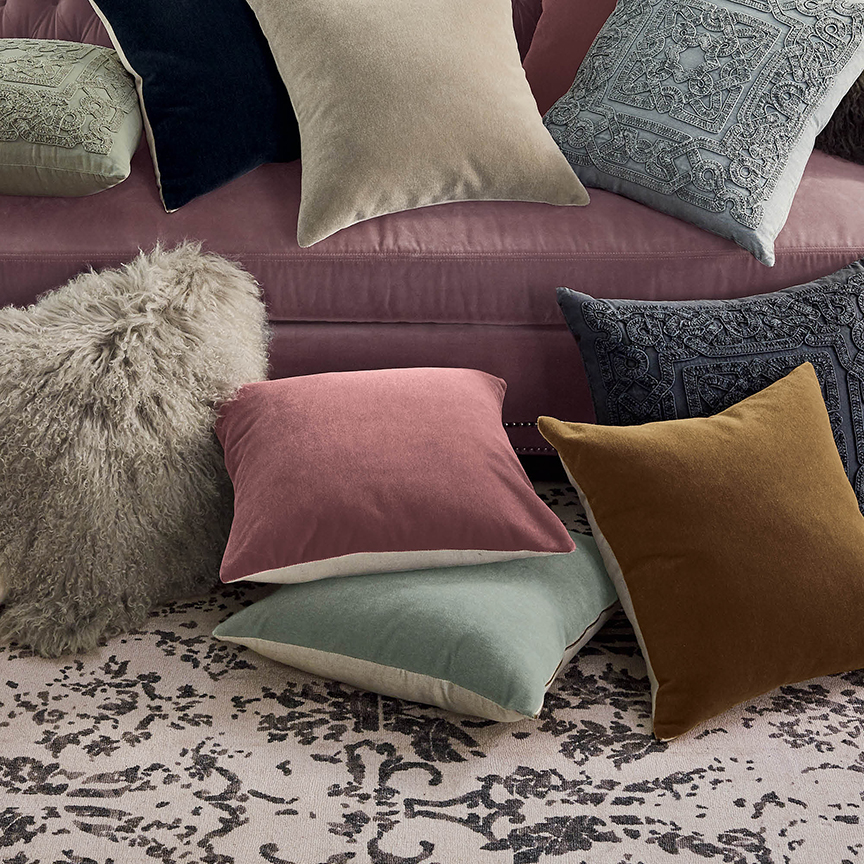
All photos courtesy Frontgate.
Offering a one-stop shop for high-end design — architecture, landscape architecture and interior design services under a single roof on Los Angeles’ famed Miracle Mile — is Studio William Hefner.
The office’s location on this stretch of Wilshire Boulevard, lined by Art Deco masterpieces and many of the city’s museums, is clearly inspirational for designers.
Originally from Northern California, Hefner arrived in Los Angeles to earn a graduate degree in architecture from UCLA and founded his current practice in 1989. He oversees a highly collaborative staff of about 35 in L.A. and maintains a smaller office in the idyllic coastal community of Montecito, outside of Santa Barbara.
Hefner, who studied art history in college and appreciates a diversity of design, draws inspiration from landmark residences scattered throughout Southern California. He is appreciative of traditionalists like Wallace Neff and Paul Williams — their Mediterranean estates have long been popular with Hollywood celebrities — as well as Mid-Century Modern masters Rudolph Schindler and Richard Neutra. As a result, Hefner’s practice encompasses a wide spectrum of architectural styles and his firm adapts to evolving preferences.
“In my practice, I try not to have a ‘signature’ style but strive toward quality design and execution in different genres, from very traditional to contemporary,” says Hefner, who reports about 60 percent of his current commissions are modern, a share that has doubled in the past decade. “Modern residential architecture has come in and out of style over the past 30 years but is finally becoming more of a lifestyle, not just a fashion or trend,” says Hefner, who adds, “I think it’s here to stay.” In Los Angeles — where so many high-end homes are in the hills or along the coast — modern design maximizes views and suits the region’s indoor-outdoor lifestyle.
Commissioned to design a massive residence on 10 precious acres in L.A.’s opulent Bel-Air neighborhood, Hefner created a formidable French-style estate known as Château des Fleurs. The client’s original inspiration was the majestic Hôtel du Cap on France’s Côte d’Azur, and Hefner conducted extensive research in Paris, Versailles and the Loire Valley to ensure that every detail was authentic. “We wanted to make sure each room was special and unique,” explains Hefner of the house, which has 31 bathrooms. Despite the scale of the project, the architect took care to create intimate, family-friendly spaces throughout the home in addition to grand rooms for entertainment.
When the 60,000-square-foot residence was completed in 2013 after five years of construction, it was the largest home in a city famous for conspicuous consumption. In his lavishly illustrated book Château des Fleurs (Pointed Leaf Press, 2016), Hefner explains a progressive approach to classic French design. “The balance of this house was to create a powerfully simple structure that would feel timeless and not imitative, while inviting an Old World opulence to the fit and finish of the architecture in a way that would be both decorative and something more: modern,” he writes.

Another more classically inspired design from Hefner is an oceanfront home in L.A.’s Pacific Palisades, a celebrity-favored enclave with a rich architectural history. This home features an Italianate design, dazzling spiral staircase and lush landscaping. In the very same community, in the foothills of the Santa Monica Mountains, Hefner authored a sprawling modern residence in which the floorplan was meticulously oriented to ensure optimal views from every room.
An approximately 7,000-square-foot home in Beverly Hills’ coveted Trousdale Estates is one of Studio William Hefner’s most notable expressions of modernism. Reminiscent of L.A.’s influential Case Study Houses from prominent Mid-Century Modern architects, it was commissioned for a client with an extraordinary modern art collection. “Accommodating art is always a challenge in a view house,” says Hefner, who notes the requisite expanses of glass tend to limit available wall space.
In suburban Sierra Madre, a considerably more rustic community than Beverly Hills, Hefner created a thoroughly contemporary residence in an environment where Craftsman bungalows and Spanish Revival homes are the prevailing architecture. But through a generous use of stone and wood, he was able to infuse the property with considerable warmth, softening the impact of its modernist theme.
“My philosophy, in both traditional and modern homes, is to introduce spaces for indoor-outdoor living, which is a reason we offer landscape architecture among our services,” says Hefner. “In Southern California, the entire site becomes a living space, with large patios, covered outdoor living areas and landscaped courtyards that people can use throughout the year,” he explains. In Hefner-designed landscape design projects, swimming pools often double as reflecting pools, fountain-laden patios assume the serenity of Zen gardens and cacti provide a compelling complement to austere clean-lined structures.

Like New York’s idiosyncratic Peter Marino, a talent he admires, Hefner is an architect who has expanded his practice to incorporate interior design. “I always had a strong interest in interiors and was disappointed when some of my early projects were not finished the way I had envisioned them, so I began designing interiors myself,” recounts Hefner. Now heading up the interior specialty at the firm is his wife, accomplished designer Kazuko Hoshino, and the firm produces custom-made furniture and accessories that enhance the interiors she creates.
Among Studio William Hefner’s custom-made products are the Infinity console, a plane of wood supported by two circular bands of steel, and the strikingly contemporary Halo mirror with its echoes of Mid-Century Modernism. Featuring a modern simplicity are the Capri lounge chair and distinctive Willow nightstand. Even the most contemporary of these pieces can complement vintage architectural settings, as Hefner and Hoshino have demonstrated in their own 1920s residence in L.A.’s fashionable Hancock Park neighborhood.

Before Hefner founded his own company, he worked for Skidmore Owings & Merrill, one of the world’s largest and most influential architecture firms, designing high-rise commercial buildings. “It was difficult to establish a personal connection with the ultimate users of the spaces,” laments Hefner, who appreciates residential design because of the more intimate relationship it forges between architect and client. Hefner encourages clients to fully participate in the design process, stating, “I think we do a better job when they’re more involved.”
The firm’s projects continue to be concentrated in Southern California, where Hefner believes the Mediterranean climate and the indoor-outdoor lifestyle it encourages affords him a genuine freedom of creativity. However, Studio William Hefner has designed residences in countries as disparate as South Korea, Turkey and Israel, and is currently undertaking projects in Seattle, the San Francisco Bay Area and Jackson Hole, Wyoming.
Photos courtesy of Laura Hull, James Ray Spahn, and Tyler William Parker
Ditch overused gold and silver trends for charming copper hues that will add to your home’s modern, yet cozy atmosphere.
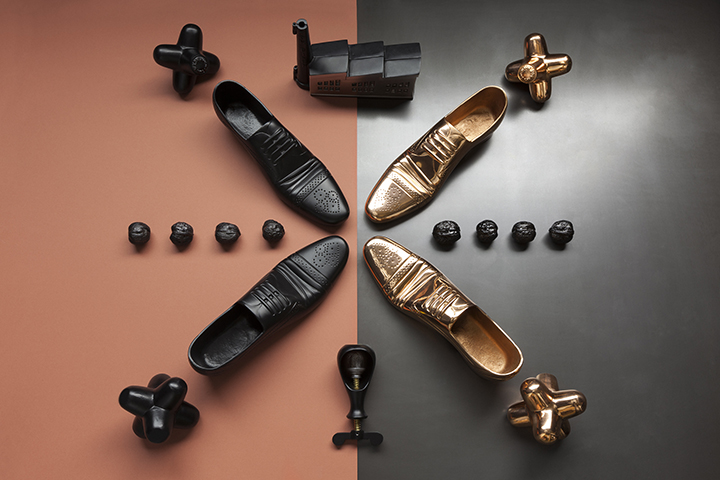
Copper’s versatility is why you should incorporate it into your decor this year. The range of shades, from pale soft tones to rich and deep copper allows for designers to work with a material and color that is complex. Silver and gold are classic, but copper is an exciting touch of diversity amongst tradition.
Copper Can Be Functional
The Hex Copper Bowl with a textured look and feel creates an eye-catching item that is unique and functional. The less-than-perfect surface of the bowl is what makes this piece interesting. The dents and bends in the metal create more than one shade of copper, which makes it more interesting than one smooth item.

Product: Hex Bowl Medium Copper
Copper as a Conversation Starter
The Tom Dixon Cast Shoe Copper is the perfect example of a playful way to bring copper into your decor. A conversation starter such as this would stand out perfectly against a navy blue wall or door. The item is cast iron, copper colored, and designed to be a door stop. This small accent piece could also help tie together other copper aspects in a room, including other shades of copper.
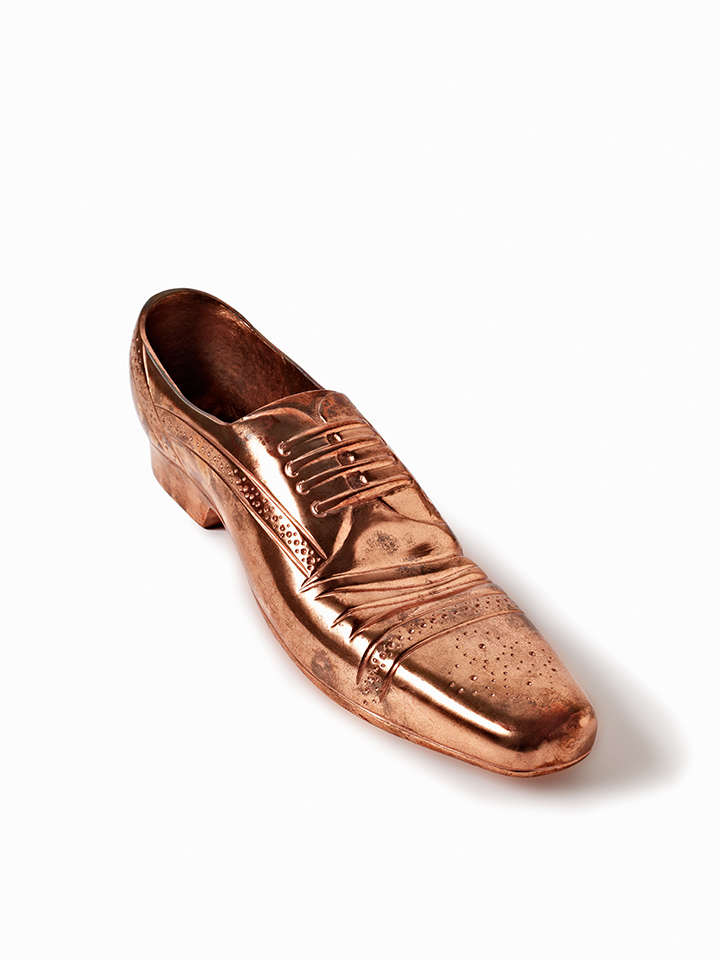
Product: Cast Shoe Copper
Ultra Sleek
The Copper Round Pendant is a perfect contrast to a rough copper bowl. The ultra sleek exterior of the pendant proves that copper is not restricted to a rustic feel. Reflective and chic, the pendant is also a conversation piece that will undoubtedly bring a modern feel to any room. Smooth and rough pieces can work together in the same space. Pairing these items is a creative way to reveal copper’s multiple layers.
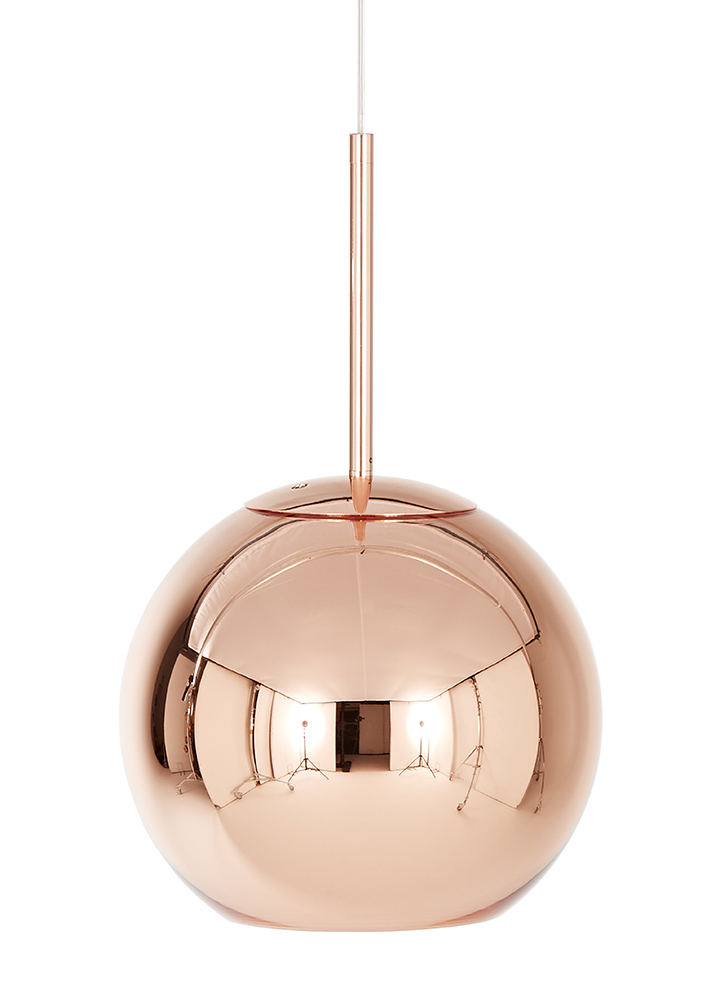
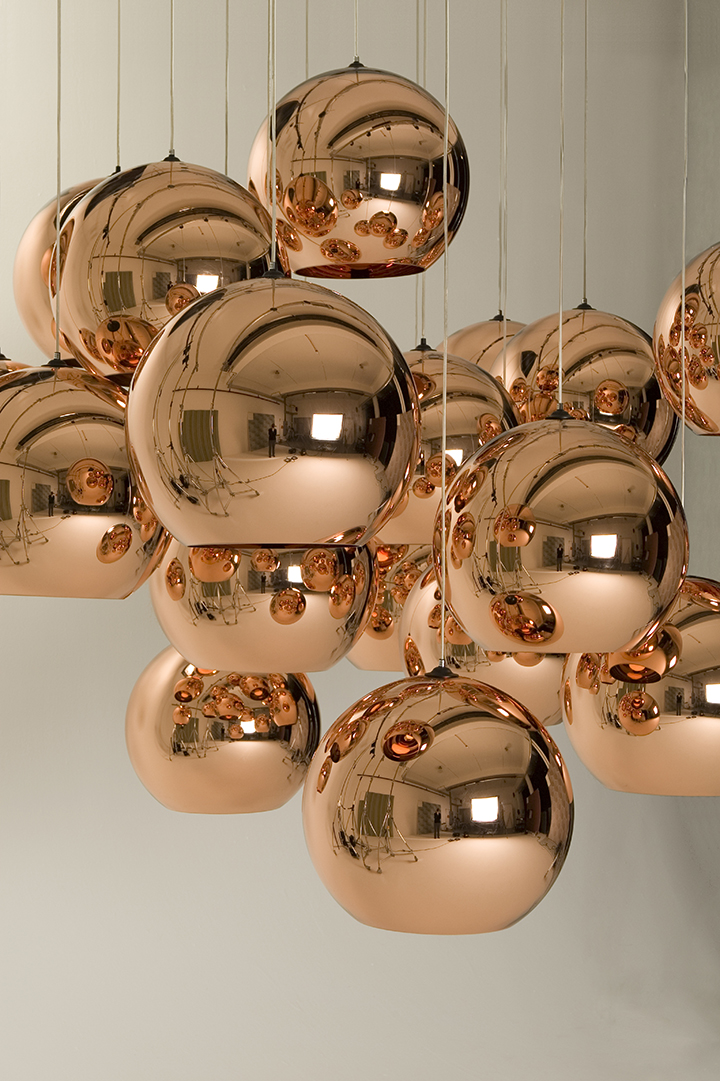
Eclectic Addition
If you are interested in using new materials or fresh colors in a room, you don’t have to commit right away. Small items, such as these Eclectic Candle London Large are easily removed or changed if you’re undecided. Candles can also accent and play off of larger copper tones that you may integrate later. Small details are what makes a room feel complete and thoughtfully put together.
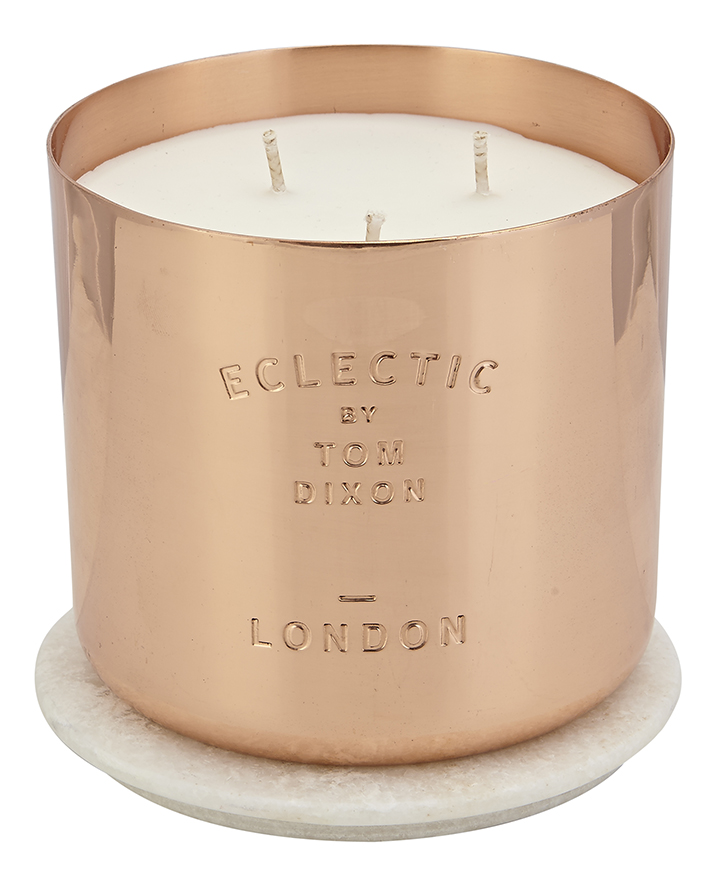
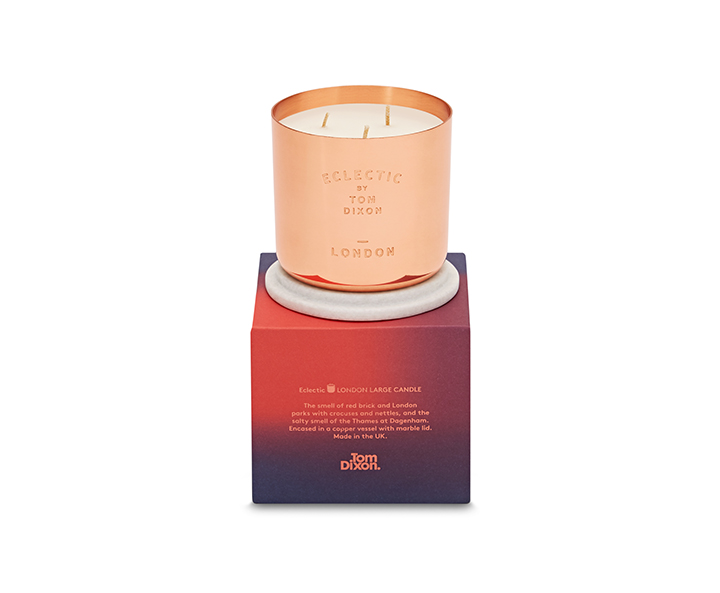
Product: Eclectic Candle London Large
Photos courtesy of Tom Dixon. Where to buy: tomdixon.net
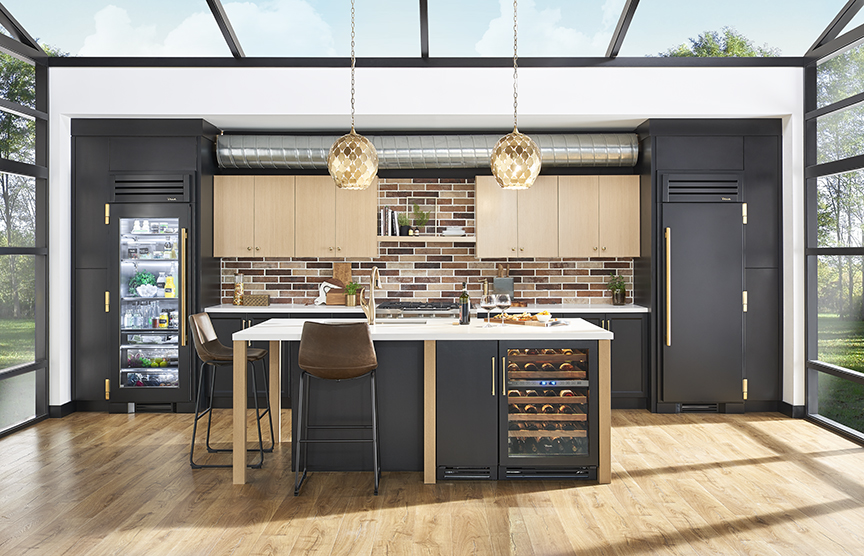
Handcrafted in America since 1945, True Residential’s commitment to American-made products goes all the way back to its beginnings as a commercial refrigeration company in St. Louis.
In today’s world, where design is specialized and unique for every home, particularly in the kitchen, the brand remains vital to the industry.
A team of designers at True Residential spoke with Unique Homes about the brand’s influence on kitchen design, both in the home and commercial spaces.
How has the appliance industry changed since True Residential began, from the early 1950s to now?
When True started in 1945, they were only selling commercial refrigeration. Throughout the ’80s and ’90s, commercial-style equipment in the home became popularized. That trend has continued to grow. Today, people have more apps and technology at their fingertips than ever before to help them cook like the pros, therefore, they’re seeking for more commercial-style equipment
True Residential has stayed true to its commercial roots providing a unique, commercially styled product that also performs like one. We are always demanding more from our appliances. True has always been at the forefront of increasing efficiency without sacrificing performance or quality. We’re proud to be an original Energy Star partner.
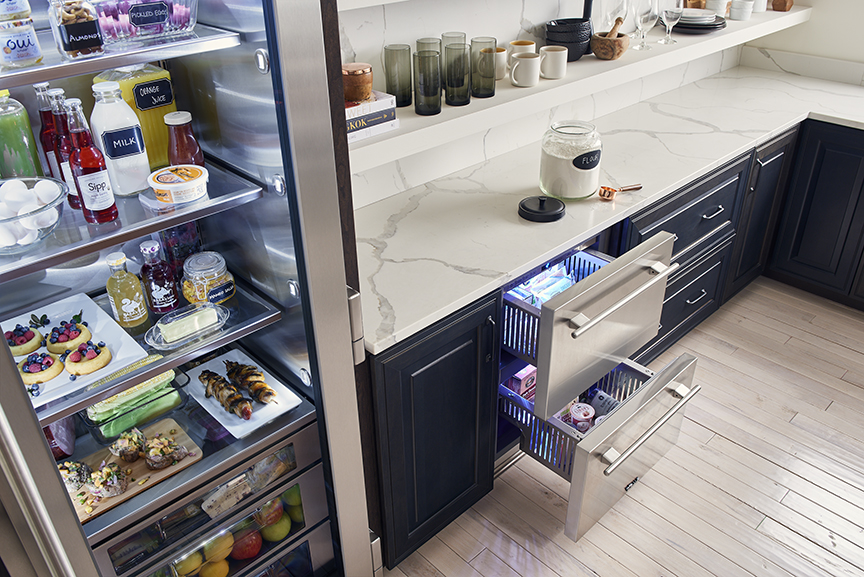
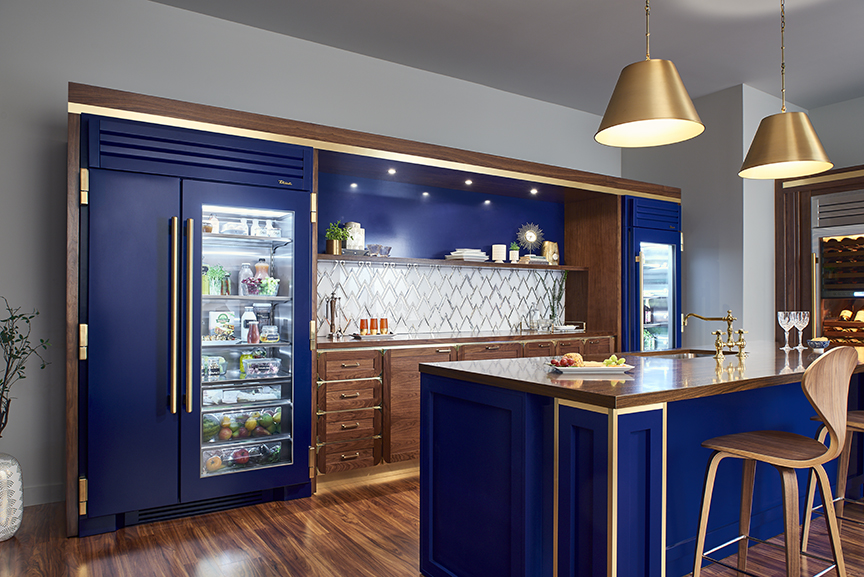
Kitchen design by Vanessa Deleon.
what is the brand's top priority with regard to design?
Providing a premium commercial-style refrigerator, both inside and out. We try to be on the forefront of trends like custom colors and various product configurations to provide truly unique options for designers, builders, specifiers, and clients.
This year we unveiled four additions to the Build Your True collection — a system that allows consumers and/or designers to choose from a variety of our products and customize them in one of our custom color and hardware finishes. To cater to the color-happy trend, we added an eye-catching cobalt blue joined by matte white and matte black finishes to round out our roster of stunning custom finishes.
what do professionals and chefs look for in appliances?
Chefs look for function above all else. We have had numerous professional chefs choose our appliances, Wylie Dufresne among them. The 42-inch fridge alone offers 24.44 cubic feet of stylish, stainless refrigeration. This detail offers chefs ample space for food storage in a hygienic environment designed to keep items fresh.
True’s cascade airflow — a system exclusive to the brand — provides consistent temperatures throughout the unit. We also outfit each refrigeration unit with incredibly sturdy drawers, offering chefs the commercial strength they rely on at work — in their own personal kitchens.
In terms of organization and style, our refrigeration units come with streamlined handles, TruLumina lighting, steel-encapsulated glass shelves, and 36 color combinations for designers and homeowners to choose from.
And while all the appliances we offer are energy efficient and designed with function and form in mind, we have the highest-performing, most energy-efficient Clear Ice Machine available on the market today.
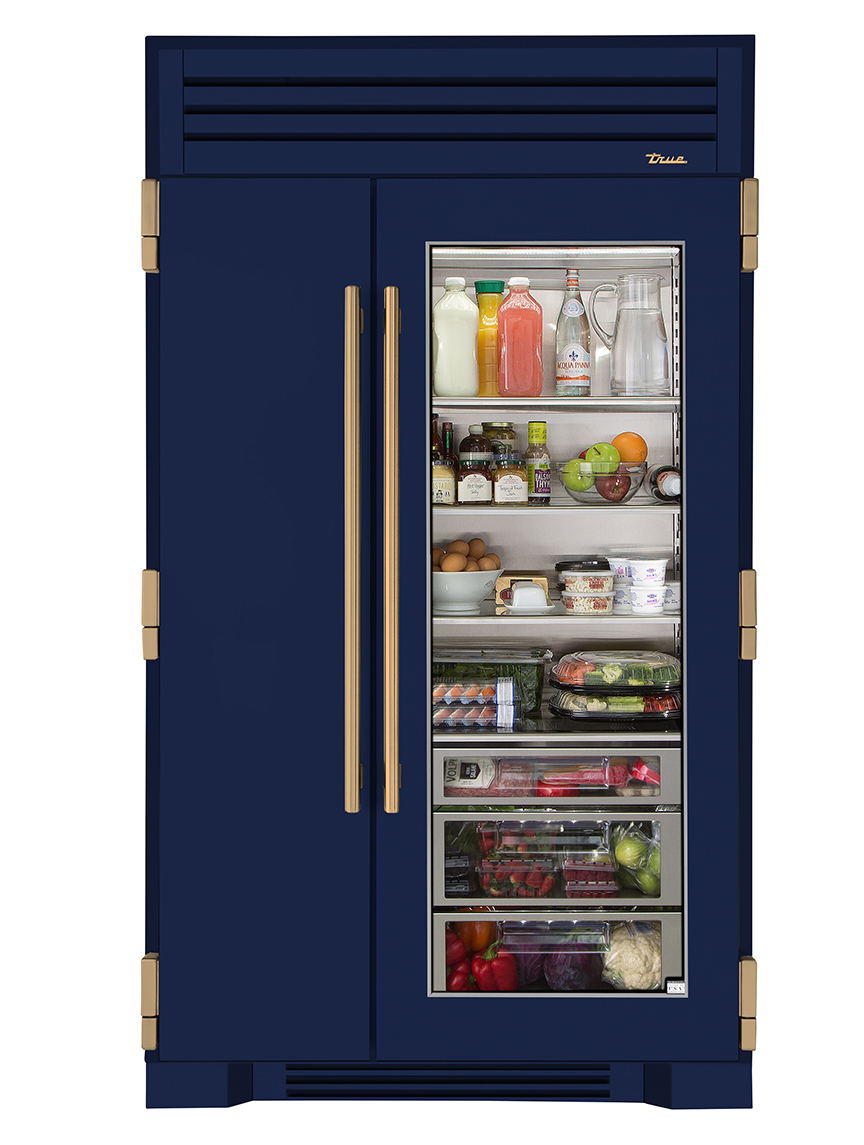
Statement throw blankets are the perfect way to seasonally decorate, soften a space, and bring a personal touch into any room.
Is there anything quite as tempting as curling up on the couch with a soft blanket?
Throws are functional and don’t crowd a space as other bulky blankets might. With the right design, fabric, and color, throws are an easy way to spruce up your decor without committing to major design changes.
Ditch boring blankets for exciting prints and cozy materials. A thoughtfully placed throw can lighten a room for summer or bring a pop of color in the winter.
Stretching a few plush throws across any bed or couch can add layers and a decorative touch. Layering is a great way to mix and match designs and add complexity to your room. The additional warmth is an easy way to spruce up your everyday furniture. Pairing throw blankets with metal furniture or placing them against other sharp surfaces can create a contrast that will entice visitors to stay awhile.
Choosing different fabrics are another way to make a statement when selecting a new throw. Ultra soft or simple comfort can help set the atmosphere of a room.
Massimo Alba’s ‘Yes Yes Yes’ blanket and Coralie Miessen’s ‘Home’ blanket are fun ways to personalize your home.
And Oyuna offers a cashmere option known as the ‘Uno Throw’ that will encourage a lazy afternoon full of lounging. After relaxing, the ‘Uno Throw’ can be casually folded across bench seating to invite guests.
Photos courtesy of WallpaperSTORE* store.wallpaper.com
Revamping past trends is hardly a new concept, but modernizing farmhouse decor can still be a challenge. Avoid cliches and break away from traditional choices that can make a space feel themed and overdone.
Focused designs call for a certain amount of balance, which is a great place to start when shopping for a specific space.
Weathered Works
Rustic and weathered pieces will be rightfully tempting. Not only do these looks add a cozy and comfortable feel to most rooms, but they’re inherently a large part of Farmhouse decor. The best way to avoid overdoing it with rustic and weathered styles is to pair them with their opposites.
Wood and stone look great with clean lines and smooth finishes. Soft fabrics and plush rugs can also be combined with natural components that will stand out among diverse materials.
Photo courtesy of Woodland Creek Furniture
Photo courtesy of Woodland Creek Furniture
Accents Not Props
Accents are the perfect opportunity to bring your room to life. A carefully chosen accent can be playful while unifying. A thoughtfully selected plant, antique sign, or a modern piece of art is an opportunity to personalize a space.
Overly obvious props will make a room feel staged. Repurposed mason jars are a thing of the past, but unique pictures of nature or wildlife are a smart way to tie in classic aspects without over-decorating.
A Touch of Nature
One or two natural elements can go a long way in Modern Farmhouse Decor. Choose a focal point to find inspiration and then build around it. Materials such as stone can be paired with modern touches to create a balanced look.
It’s easy for a modern look to take over, but polished surfaces and vibrant colors still have a place in Modern Farmhouse decor when they work together with other influences.
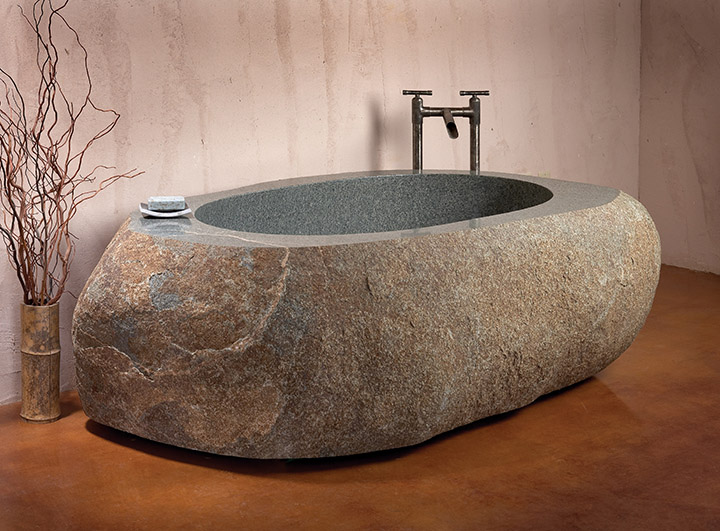
Stone Forrest Natural Bathtub
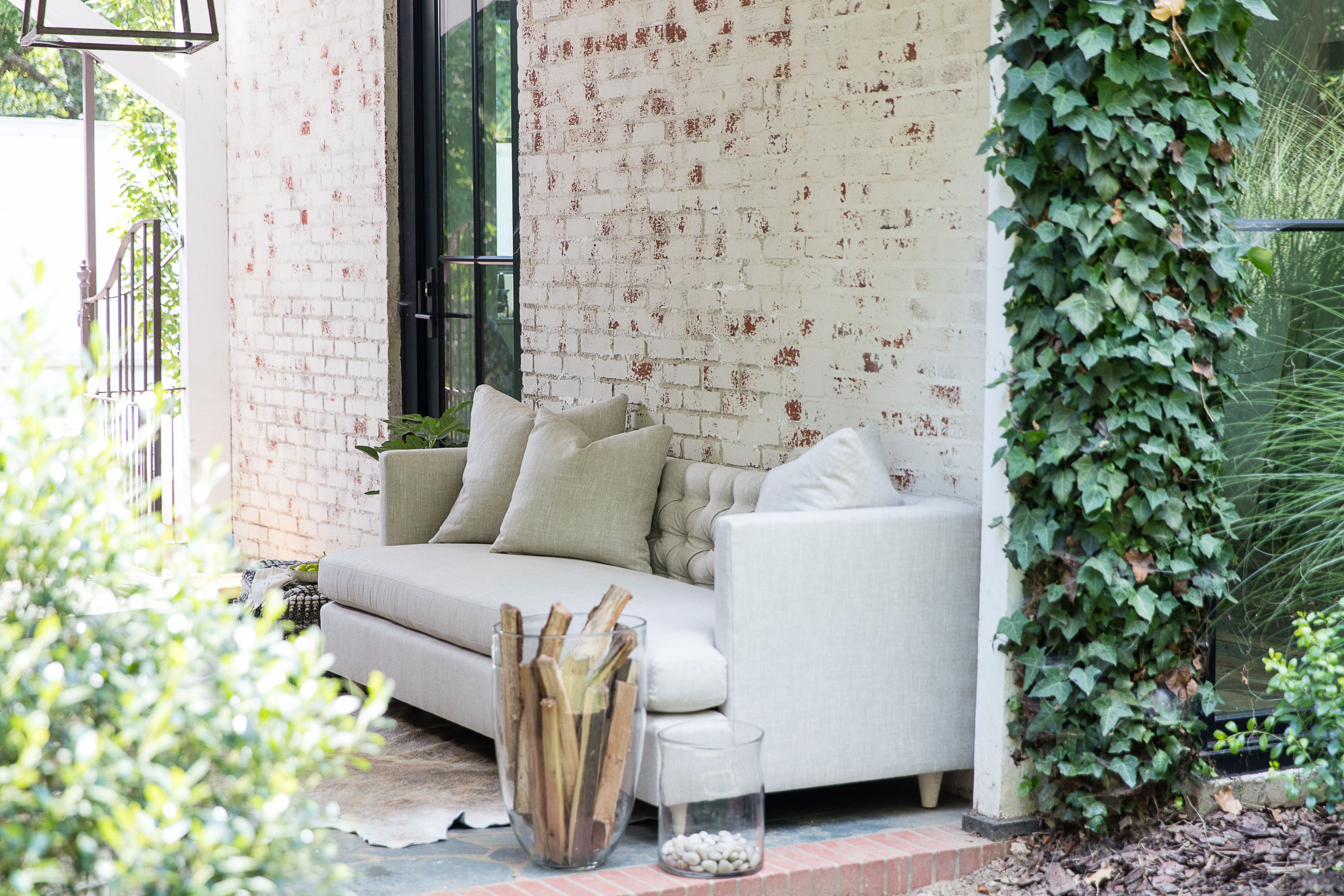
Photo by Bert Vanderveen, Verellen Furniture
Neutral Not Boring
Neutral colors such as tan and gray urge accents to really pop. A textured, gray fabric will highlight greenery or the subtle reds in a brick wall. Neutral flooring and walls are another way to keep Farmhouse decor modern.
Painted wood floors or a rustic paint job over brick is key to sprucing up traditional farmhouse elements.
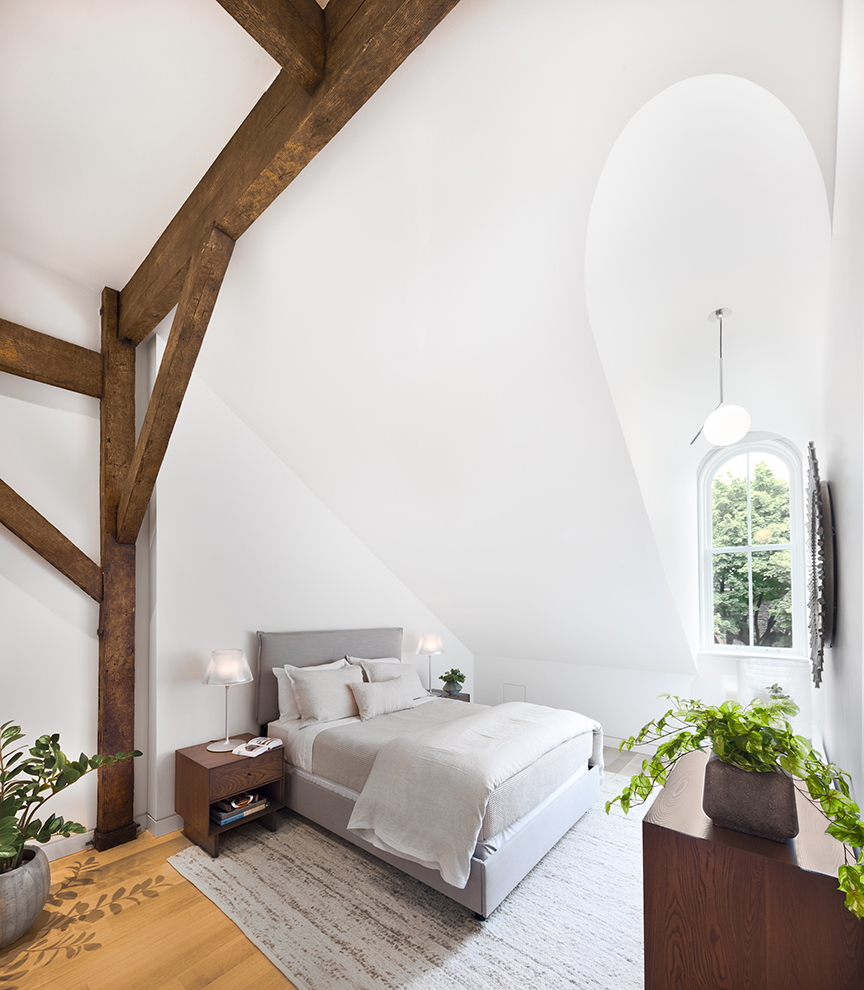
Residences at Prince Street. Photo courtesy Aaron Thompson.
Outfitting homes with an artistic ceiling creates a complete, dynamic space, often tying assorted aspects of home design together, from art to functioning space. In these examples, designers inspired to use interesting techniques have created complex designs that demand people to look up.
Gallery-Style Spaces
The character of a home is often shaped by the items inside it, including art or artistic detailing. Helping to define a home’s character, high ceilings within the home allow ample wall space for art lovers to adorn their walls with prized masterpieces. One example is seen in this Artefacto-designed residence in Bal Harbour, Florida, which boasts 10-foot-plus ceilings with customized panel backlights and recessed lights. The Oceana Bal Harbour unit also features floor-to-ceiling windows framing the breathtaking ocean and Intracoastal views.
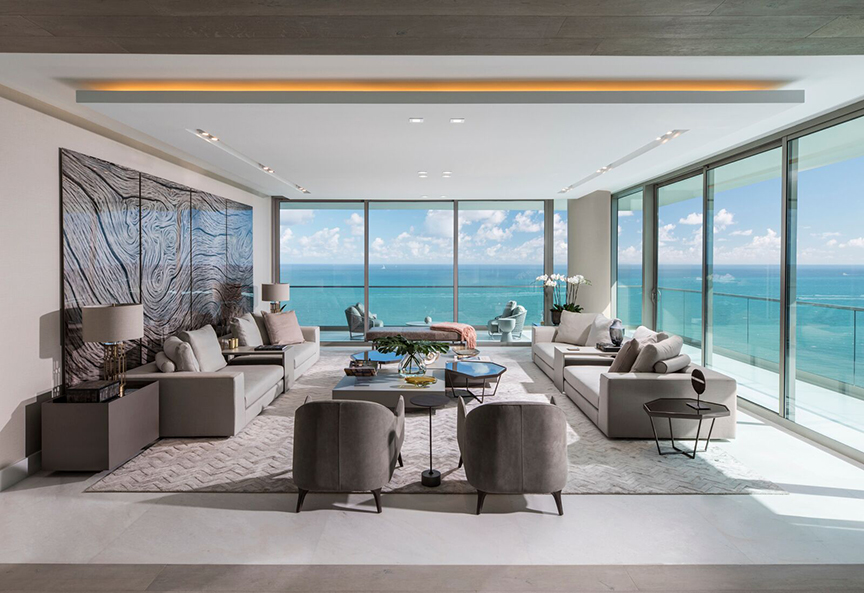
Photo courtesy Barry Grossman.
Embracing the Outdoors
A space can evoke different feelings depending on the environment, both inside and out. To embrace the elements, some spaces utilize the outdoors by bringing them in. Miami’s Brickell City Centre boasts a $30 million climate ribbon, a steel-and-glass elevated trellis that hovers over the retail center. An achievement in artistry and first of its kind, guests and residents of Reach and Rise can gaze at the sculptural element, as it protects them from inclement weather, captures sea breezes to regulate air flow and temperature, collects rainwater for reuse and allows them to enjoy natural light in an open-air environment.
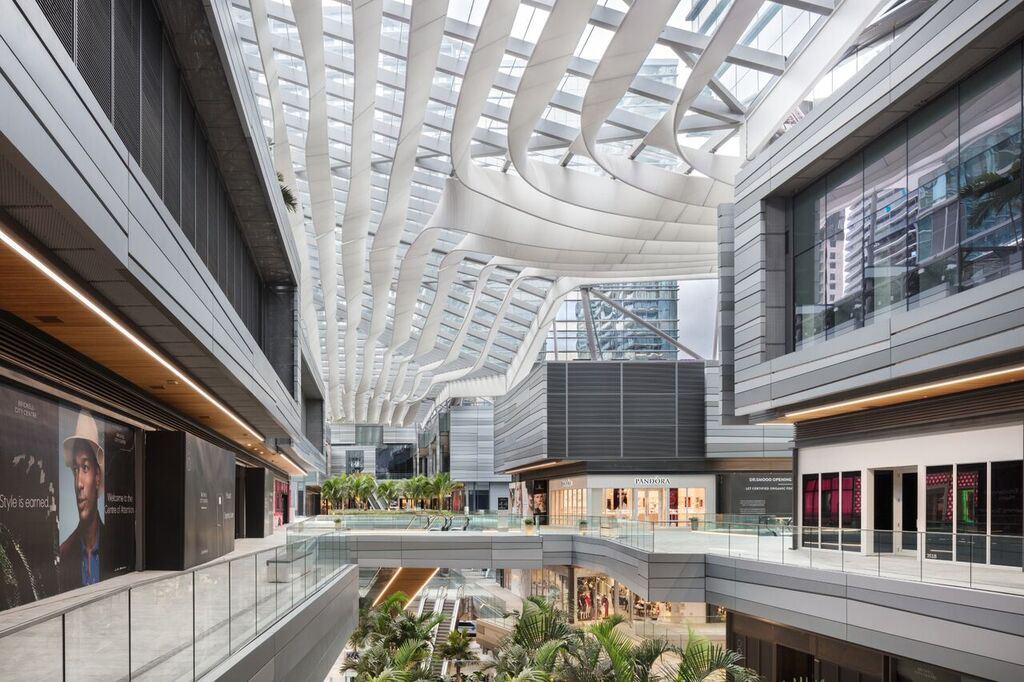
Photo courtesy Brickell City Center.
Smiling at the Past
Historical architecture is highly appreciated in the design industry, as it creates a traditional atmosphere for designers to either enhance or refresh with modern additions. These traditional styles of architecture extend into the home, seen through classic ceilings that add a unique element to the space. Residences at 62-66 North Third in North Williamsburg, New York, feature exposed, high concrete ceilings as a nod to the neighborhood’s industrial past. The residences embody a sense of character, design, and detail that combines modern and traditional Williamsburg in these expansive homes.
Another example with an authentic ceiling design is in this top-floor townhouse at the Residences at Prince Street, formerly part of St. Patrick’s Old Cathedral. The gabled ceilings with exposed wood beams reflect an authentically of the period; existing moldings and details were replicated throughout to create a top-floor living area with skylights and a cozy feel.
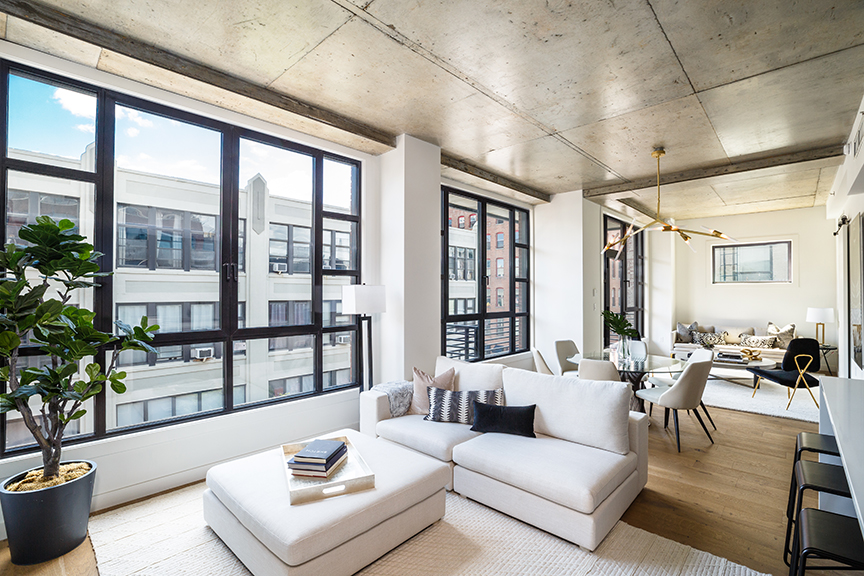
Photo courtesy MNS.


